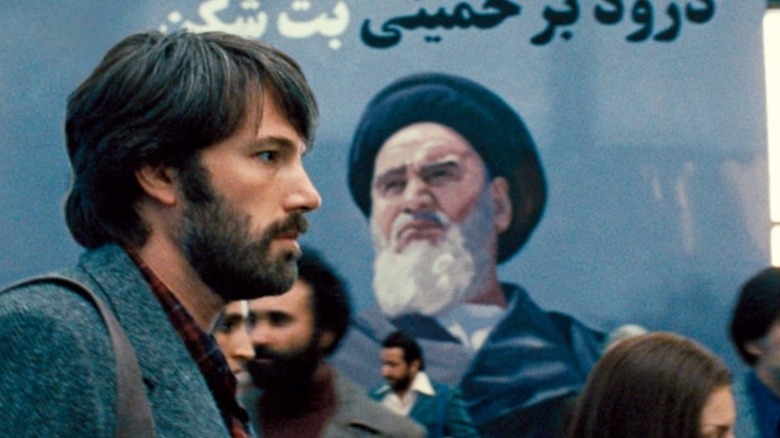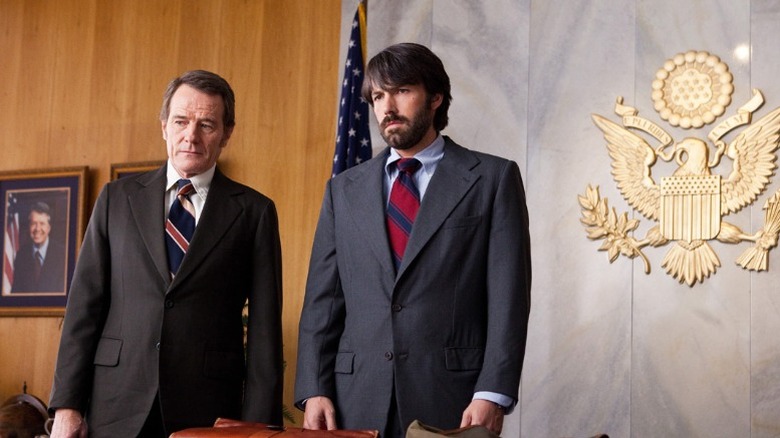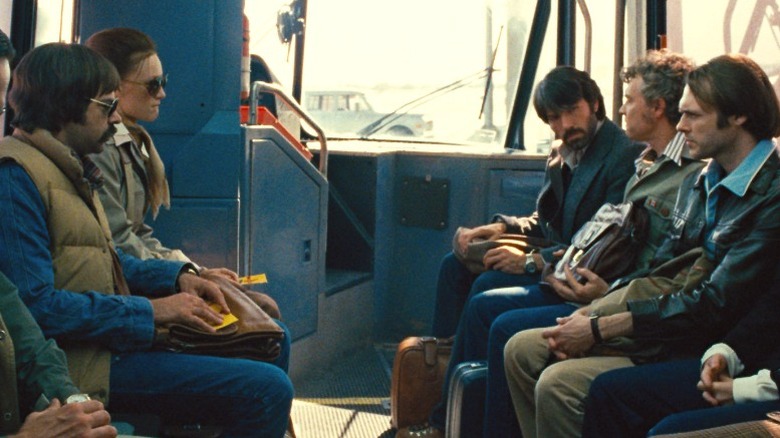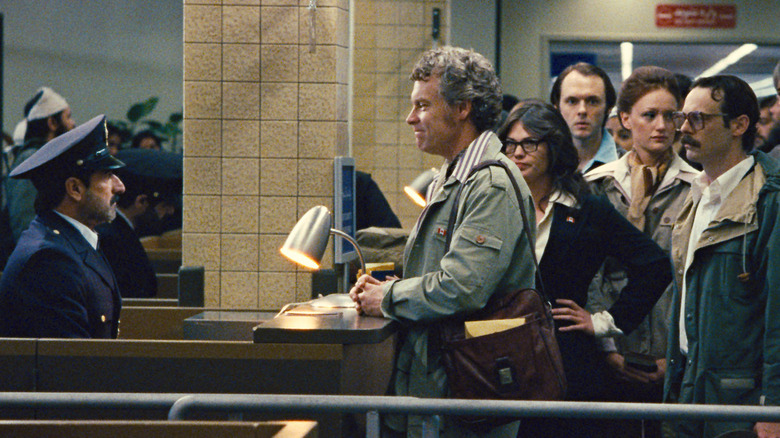Why Ben Affleck Bent The Truth With His Argo Adaptation
With his 2012 film "Argo," Ben Affleck was able to break out of Boston, particularly the crime thrillers on which he'd made his name. As good as "Gone Baby Gone" and "The Town" were, "Argo" was a film of greater scope and ambition, telling a (somewhat) true story set at the height of the 1970s Iranian Revolution. In particular, it deals with the efforts of the CIA to extract six American embassy staffers who evaded mass arrest by the Iranian government by hiding out in the home of Canadian ambassador Ken Taylor.
On the surface, the story (adapted from the Wired article "The Great Escape" by Joshuah Bearman) was open to the kind of gritty sensibility that Affleck had brought to his previous films. Beneath that, the escape plan in question — members of the CIA pose as a Canadian film crew, pretending to scout locations for a science-fiction film — was a natural recipe for a good suspense movie. And the situation's geopolitical complexities could hardly be reduced to a simple Hollywood narrative, although Affleck and writer Chris Terrio would try their best, bending the truth as much as necessary.
In the end, "Argo" would see a lot of praise. Its command of tone, meticulous plotting, and excellent supporting cast made it a shoe-in come awards season, and it even won Best Picture at the Academy Awards. But its flattening of the true story saw criticism.
The Canadian take
In 2012, Ben Affleck told Rolling Stone that "Chris Terrio, our screenwriter, is really good at taking real life, which does not have a three-act structure, and turning it into something that does." The vast complexity of the Iranian hostage crisis, wherein much of the staff of Tehran's U.S. embassy was kidnapped and taken hostage for over a year during the country's revolution, would not have easily lent itself to a two hour movie. But that was Terrio's job: finding some structure in the mess of the overarching story, not unlike his role in co-writing "Star Wars: The Rise of Skywalker."
Terrio's dramatic restructuring included diminishing the international cooperation behind the rescue. "Argo" emphasizes the role of the CIA, focusing in particular on "exfiltration" expert Tony Mendez (Affleck) devising a rescue plan for the six escaped hostages from Tehran. In the film, all six Americans hide out in the home of Canadian Ambassador Ken Taylor, but in real life, four stayed with Canadian diplomat John Sheardown.
The movie's telling gives practically all rescue credit to the CIA, but many Canadian viewers, and even the real Taylor (who told Maclean's "I just think they didn't want to be bothered with the facts"), took issue with its erasure of their government's contributions. Meanwhile, Jimmy Carter, the U.S. President at the time of the incident, found the movie's depiction inaccurate. As he told CNN (via Politico), "the main hero was Ken Taylor."
Amping up the suspense
Chris Terrio told the WGA that he was "a little bit afraid of the tonal dissonance of the material." The tone he ultimately developed was heightened: suspenseful, tense, but always with an eye on entertainment. The movie's depiction of Hollywood inside baseball, as Mendez and a film producer (Alan Arkin) develop their fake movie, called "Argo," makes for some of its funniest material. To fit that in with the suspenseful final act took some embellishment.
"Argo" treats the escapees' conditions in the home of Ken Taylor as something like prison, claustrophobic and dim. "It's not true we could never go outside," claimed Mark Lijek, one of the six escapees, to BBC. But locking these characters in the same room does make for more engaging drama, especially as the clock ticks on the mission. The movie also transforms the actual escape from Iran into a setpiece, loaded with obstacles and reversals. As Mendez enters the country and meets with the escapees, posing undercover as part of a film crew, there's immediate tension. When the escapees do go outside for the first time, suspicion abounds.
When President Carter cancels the mission, Mendez has to fight with his boss (Bryan Cranston) to reauthorize it in time now that all the pieces for the rescue are present. There's an argument at the airport that leads to the escapees' identities being compromised, and they board the plane while practically being chased by Revolutionary Guards. It's a great climax for one of Ben Affleck's best movies. But it wasn't the truth.
Smooth flying
In real life, the plane took off fine and there were few hiccups if any at the airport. Ken Taylor told Maclean's that "the departure went very smoothly," and that none of the complications faced by the escapees' or Mendez in the film actually happened. For Ben Affleck and Chris Terrio, that's the nature of the beast, of turning real life into cinematic drama.
Terrio saw it abstractly. While everything may have gone smoothly, the threatening nature of what could have gone wrong surely lingered on everyone's minds. To accurately convey the high stakes of the scenario, he felt as a dramatist that he needed to externalize those fears with major incidents that could wreck the whole mission. It also makes for a more thrilling capper to the movie than simply waiting at the airport would have been. Maclean's reports Terrio as saying at the film's TIFF press conference, "There is a catharsis when the plane takes off. To create that in cinematic form requires a lot of amp-up and drama to replicate what the house guests might have felt at that moment."
In the end, "Argo" succeeds as a thriller even if it fails as a historical retelling. If Affleck is really done with IP-driven movies, we can only hope he goes back to great entertainments in the vein of "Argo."



